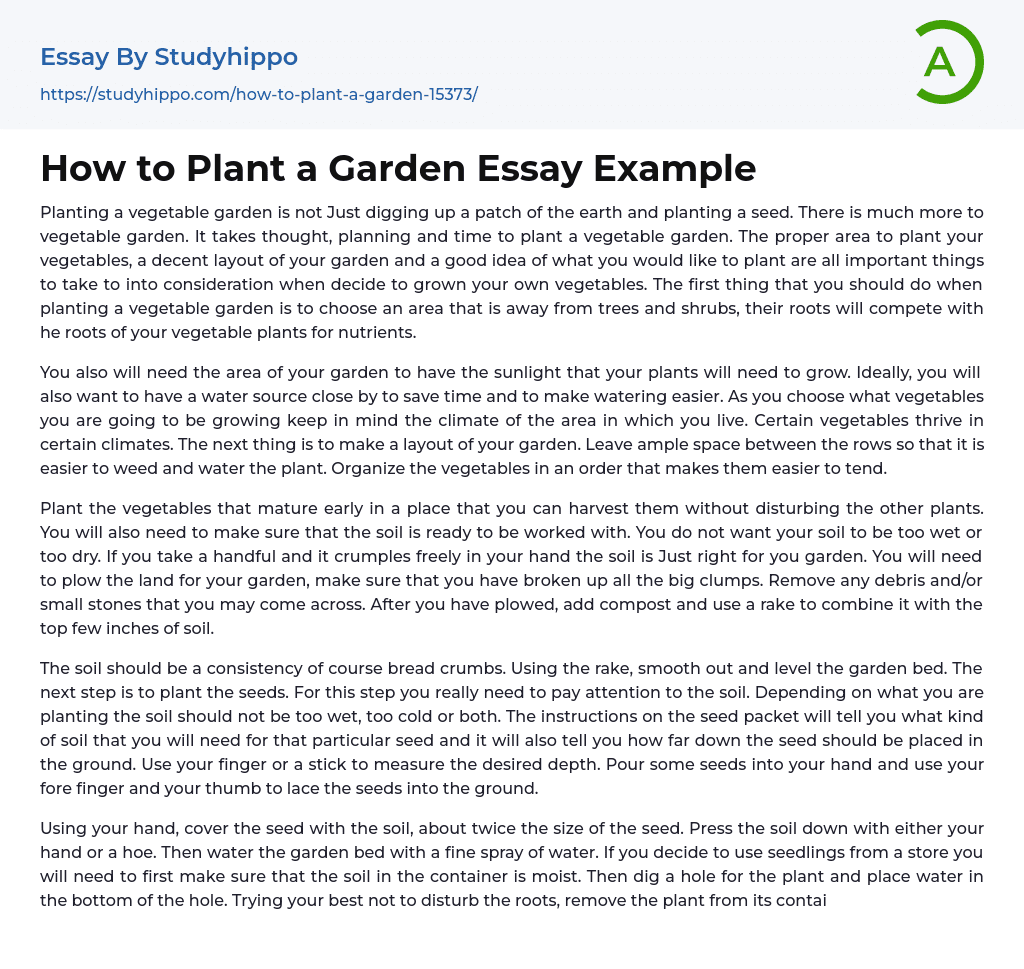Planting a vegetable garden is not Just digging up a patch of the earth and planting a seed. There is much more to vegetable garden. It takes thought, planning and time to plant a vegetable garden. The proper area to plant your vegetables, a decent layout of your garden and a good idea of what you would like to plant are all important things to take to into consideration when decide to grown your own vegetables. The first thing that you should do when planting a vegetable garden is to choose an area that is away from trees and shrubs, their roots will compete with he roots of your vegetable plants for nutrients.
You also will need the area of your garden to have the sunlight that your plants will ne
...ed to grow. Ideally, you will also want to have a water source close by to save time and to make watering easier. As you choose what vegetables you are going to be growing keep in mind the climate of the area in which you live. Certain vegetables thrive in certain climates. The next thing is to make a layout of your garden. Leave ample space between the rows so that it is easier to weed and water the plant. Organize the vegetables in an order that makes them easier to tend.
Plant the vegetables that mature early in a place that you can harvest them without disturbing the other plants. You will also need to make sure that the soil is ready to be worked with. You do not want your soil to be too wet or too dry. If you take
handful and it crumples freely in your hand the soil is Just right for you garden. You will need to plow the land for your garden, make sure that you have broken up all the big clumps. Remove any debris and/or small stones that you may come across. After you have plowed, add compost and use a rake to combine it with the top few inches of soil.
The soil should be a consistency of course bread crumbs. Using the rake, smooth out and level the garden bed. The next step is to plant the seeds. For this step you really need to pay attention to the soil. Depending on what you are planting the soil should not be too wet, too cold or both. The instructions on the seed packet will tell you what kind of soil that you will need for that particular seed and it will also tell you how far down the seed should be placed in the ground. Use your finger or a stick to measure the desired depth. Pour some seeds into your hand and use your fore finger and your thumb to lace the seeds into the ground.
Using your hand, cover the seed with the soil, about twice the size of the seed. Press the soil down with either your hand or a hoe. Then water the garden bed with a fine spray of water. If you decide to use seedlings from a store you will need to first make sure that the soil in the container is moist. Then dig a hole for the plant and place water in the bottom of the hole. Trying your
best not to disturb the roots, remove the plant from its container and place it in the hole. Fill the area around it with soil and gently but firmly press down with your fingers.
You will then need to water your plants. It is very important to not let these plants dry out. If the weather is quite hot you may need to water these plants two times a day. As your garden is growing you will need to maintain it. Removing the weeds that come up is easiest to do when the weeds themselves are small and the ground is damp. A garden needs water for a steady growth, if there is no rain, you will need to water your garden often. Once the vegetable plants have been established, fertilizer may be used to give your plants a boost during their growing season.
If the getable that you are planting needs to be staked, to keep it off the ground, it is best to do this when planting your garden. This will keep from disturbing the roots at a later date. Certain vegetables will need some protection from the elements. If the climate becomes too cold cucumbers can be in danger. If the weather becomes too hot spinach will be in at risk. Refer to the instructions on the seed packet to determine if these precautions need to be made. Finally the time comes for you to harvest your garden. Certain vegetables, like tomatoes, can be harvested many times throughout the growing season.
But others like corn can only be harvested once. Each vegetable has its own time when it is to be harvested.
Harvesting can be the richest reward from planting your own garden. Whether you decide to use seeds or seedlings, placing your garden in the best location possible will aid in the growth of your vegetables. Taking the time to develop a workable layout will be beneficial to you, the gardener, as you are tending and when the time comes to harvest. Ultimately, in the end, using a little patience and time you will be reaping the rewards of fresh vegetables in your home and more green in your wallet.




